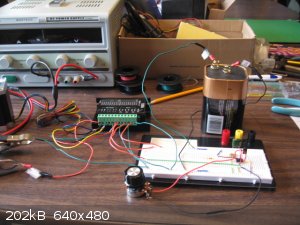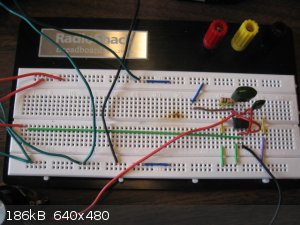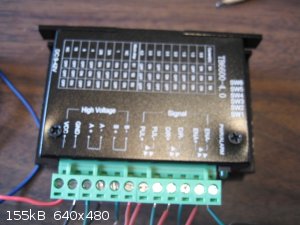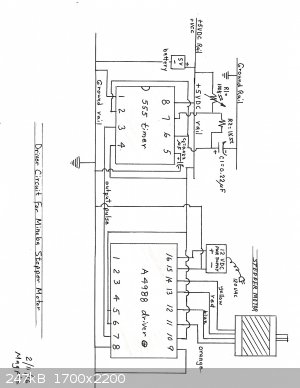| Pages:
1
..
6
7
8
9 |
wg48
National Hazard
   
Posts: 821
Registered: 21-11-2015
Member Is Offline
Mood: No Mood
|
|
Don't forget the interface spec for the module (not the TD6600) spec). Perhaps a new mutimeter at the same time.
Hope you have better luck with the next one.
|
|
|
Twospoons
International Hazard
    
Posts: 1281
Registered: 26-7-2004
Location: Middle Earth
Member Is Offline
Mood: A trace of hope...
|
|
Certainly starting to look like its the driver thats busted. Odd - those things are usually fairly robust. Must have been DOA. Unless you managed to
connect power to the motor terminals by accident, I can't see how you could have damaged it.
Helicopter: "helico" -> spiral, "pter" -> with wings
|
|
|
Magpie
lab constructor
    
Posts: 5939
Registered: 1-11-2003
Location: USA
Member Is Offline
Mood: Chemistry: the subtle science.
|
|
Victory! I set up another breadboard using a 555 timer and an A4988 driver. This was used to drive my old NEMA 17 Mineba stepper motor. It worked
per design!
It's looking more and more like the Toshiba 6600HG driver is at fault.
The single most important condition for a successful synthesis is good mixing - Nicodem
|
|
|
Twospoons
International Hazard
    
Posts: 1281
Registered: 26-7-2004
Location: Middle Earth
Member Is Offline
Mood: A trace of hope...
|
|
Given the price of that module, it is entirely possible they don't test at the factory - just replace the dead ones returned by customers. Testing
costs money - and when you have yields exceeding 99.9% its wasted money.
Of course its frustrating for the customers who do get bad ones.
Helicopter: "helico" -> spiral, "pter" -> with wings
|
|
|
Magpie
lab constructor
    
Posts: 5939
Registered: 1-11-2003
Location: USA
Member Is Offline
Mood: Chemistry: the subtle science.
|
|
I just got the Zyltech NEMA 23 to operate using the A4988 driver. At 30vdc it reached an estimated 800 rpm (by ear). But then I couldn't get it to
operate again.
[Edited on 9-2-2018 by Magpie]
The single most important condition for a successful synthesis is good mixing - Nicodem
|
|
|
violet sin
International Hazard
    
Posts: 1475
Registered: 2-9-2012
Location: Daydreaming of uraninite...
Member Is Offline
Mood: Good
|
|
https://www.pololu.com/product/1182
""Allegro’s A4988 microstepping bipolar stepper motor driver features adjustable current limiting, over-current and over-temperature protection, and
five different microstep resolutions (down to 1/16-step). It operates from 8 V to 35 V and can deliver up to approximately 1 A per phase without a
heat sink or forced air flow (it is rated for 2 A per coil with sufficient additional cooling). ""
So it may just be temporarily off for temp/etc. reasons. Try again in a little while, maybe it will be back in order.
|
|
|
Magpie
lab constructor
    
Posts: 5939
Registered: 1-11-2003
Location: USA
Member Is Offline
Mood: Chemistry: the subtle science.
|
|
I tried running the Zyltech again several hours later. It would not go; but it vibrates strongly like it wants to go. The rotor locks.
I replaced the A4988 driver but this made no difference. The max amps was only 0.3. There is a heat sink on the driver.
I have 2 other NEMA17s. Both are OMCStepperOnline: models 17HS13-0316S and 17HS19-0406S. Neither would even vibrate.
The single most important condition for a successful synthesis is good mixing - Nicodem
|
|
|
wg48
National Hazard
   
Posts: 821
Registered: 21-11-2015
Member Is Offline
Mood: No Mood
|
|
Its relatively easy to perform a crude check on your motors using the electrons from your 6V battery (the electrons that do like or at least don’t
hate you as much as the module electrons do ) by doing the job of a motor driver yourself. Momentary (~1s to avoid over heating the winding) connect
one of the motor phases across to the 6V battery buttons, then momentary connect the other phase, then the first phase again then the other phase and
so on. The motor should make a single step (a few degrees of movement) each time you energise the phases in turn. Depending on the initial position of
the rotor it my not move on the first application of the battery.
It is desirable to have your fingers in contact with both conductors when you disconnect from the battery to provide a path for the back emf to limit
it to safe levels for the motor insulation The will have the additional benefit of give you an indication of how much the electrons do like you or
not dependent on the level of electric shock you feel. Thinking about it perhaps it it will be best to risk failure of the motor insulation than risk
testing the affections electrons to you as I suspect all electrons like to mess with you. LOL
(The comments about electrons is a joke as indicated by the LOL)
|
|
|
Pumukli
National Hazard
   
Posts: 686
Registered: 2-3-2014
Location: EU
Member Is Offline
Mood: No Mood
|
|
- not important comment -
This proposed test reminds me my own experiences with affectionate electrons.
When I was 7 or 8 there was a period when I liked putting a 4.5V battery across each free hanging electric leads I came across in the hope the device
under test would do something interesting.
Well, I quickly learned to approach more cautiously such conductors when I put the battery across a salvaged mains transformer 
The final "enlightment" came a few years later when I repeated the experiment with a 12V car battery attached to a "naked" (= removed from its metal
enclosure) car ignition coil and somehow touched the wrong lead while disconnecting the well energized primary. 
|
|
|
Twospoons
International Hazard
    
Posts: 1281
Registered: 26-7-2004
Location: Middle Earth
Member Is Offline
Mood: A trace of hope...
|
|
If the motor is locked but not rotating I'd guess one phase is not connected properly.
Helicopter: "helico" -> spiral, "pter" -> with wings
|
|
|
Magpie
lab constructor
    
Posts: 5939
Registered: 1-11-2003
Location: USA
Member Is Offline
Mood: Chemistry: the subtle science.
|
|
I have a Mineba unipolar (2 phases, 6 wires) that I have been using in the bipolar mode (2 phases, 4 wires). In this mode I am using red-yellow for
phase 1 (0 resistance between them) and blue-orange for phase 2 (0 resistance between them). I had this motor operating yesterday but now it is
locked rotor. In what sequence should I place the terminals on the A4988 driver? I've tried a) red, yellow, blue, orange, b) red, yellow, orange,
blue, and c) orange, red, yellow, blue. I get locked rotors but no motor operation.
My ohm meter will not discriminate between the outer terminals of a phase coil and an outer terminal and center tap terminal, ie, they both read 0.
[Edited on 10-2-2018 by Magpie]
The single most important condition for a successful synthesis is good mixing - Nicodem
|
|
|
Twospoons
International Hazard
    
Posts: 1281
Registered: 26-7-2004
Location: Middle Earth
Member Is Offline
Mood: A trace of hope...
|
|
You really need to get a better meter. Or possibly replace the battery in your current one?
You really are having a rough time with your steppers. It shouldn't be this hard to get them running.
Helicopter: "helico" -> spiral, "pter" -> with wings
|
|
|
Magpie
lab constructor
    
Posts: 5939
Registered: 1-11-2003
Location: USA
Member Is Offline
Mood: Chemistry: the subtle science.
|
|
I am in the process of getting a meter than can measure down to 1 ohm. I just received a Fluke 101 digital multimeter. The resistance function does
not work so I will be calling Fluke tomorrow.
But I don't think this will help, really. My internet search brought up only one Megger ohmmeter capable of reading down to 0.025Ω. Cost: $3910
(free shipping...chuckle) from Davis. Test Equip. Depot has a Megger meter that will read 1.9999 Ω full scale but don't give a price.
If you can recommend a suitable meter at a reasonable price let me know.
I've been thinking this for some time now.
-----------------------------------------------------------------------
I received my new Toshiba driver for the Zyltech stepper motor yesterday. I hooked it up as shown in the pictures attached. It did not work.
  
[Edited on 11-2-2018 by Magpie]
The single most important condition for a successful synthesis is good mixing - Nicodem
|
|
|
Twospoons
International Hazard
    
Posts: 1281
Registered: 26-7-2004
Location: Middle Earth
Member Is Offline
Mood: A trace of hope...
|
|
Pretty much any digital meter should be capable of 0.1 ohm resolution, on a 100 ohm fullscale setting. Certainly the Fluke 101 is capable of showing
tenths of an ohm. They're usually a pretty reliable brand (or always have been), and tend not to misread with a tired battery the way some of the
dirt cheap chinese meters do.
Personally I have one made by Keysight (who used to be Agilent who used to be Hewlett-Packard), but its a $400 meter - probably more than most
hobbyists want to spend!
Heres another thing you can try : set your power supply to 1V , and the current limit to about 1A, and connect it directly to the motor winding. Read
the current off the power supply. 1 divided by this number will be your winding resistance.
Helicopter: "helico" -> spiral, "pter" -> with wings
|
|
|
wg48
National Hazard
   
Posts: 821
Registered: 21-11-2015
Member Is Offline
Mood: No Mood
|
|
magpie: Do you now have an interface spec for the new module?
Here is the first multimeter I found with a spec on ebay for ~£16
3+1/2 digits 200ohm range with a resolution of 0.1 ohms, crap accuracy but it is only ~£16. You should be able to find the mid point of your motor
windings with it.
https://www.ebay.co.uk/itm/Multimeter-Neoteck-Auto-Ranging-D...
There are hundreds on ebay but check the specification.
[Edited on 12-2-2018 by wg48]
Sorry forgot the link
[Edited on 12-2-2018 by wg48]
|
|
|
Magpie
lab constructor
    
Posts: 5939
Registered: 1-11-2003
Location: USA
Member Is Offline
Mood: Chemistry: the subtle science.
|
|
Zyltech sent me nothing on the module. I don't know what an interface spec is or where to get one.
The single most important condition for a successful synthesis is good mixing - Nicodem
|
|
|
wg48
National Hazard
   
Posts: 821
Registered: 21-11-2015
Member Is Offline
Mood: No Mood
|
|
The interface spec tells you what the inputs and outputs are. So with out it how are you going to trouble shoot it? You still will not know for
certain if you are interfaceing to it correctly or not.
|
|
|
violet sin
International Hazard
    
Posts: 1475
Registered: 2-9-2012
Location: Daydreaming of uraninite...
Member Is Offline
Mood: Good
|
|
I've been successfully using free multimeters from harbor freight. Spend 5$ on anything get one free. Before we had a dollar store I used them for
free 9v batteries, as they were 5$ from the grocery store. Someone borrowed the radio shack one years ago. I have the 7$ ohm/F/L/esr meter
http://www.hfqpdb.com/best_coupon/7+Function+Digital+Multime...
https://m.ebay.com/itm/LCR-T4-ESR-Meter-Transistor-Tester-Di...
There are more than a few acceptable meters on eBay for 20$ or less. Hz and thermocouple settings on some look useful.
https://m.ebay.com/itm/Smart-V-True-RMS-Auto-Ranging-Multime...
|
|
|
Magpie
lab constructor
    
Posts: 5939
Registered: 1-11-2003
Location: USA
Member Is Offline
Mood: Chemistry: the subtle science.
|
|
Attached is a cleaned up circuit that started right off turning my Mineba NEMA 17 stepper motor salvaged from a dead copier. Speeds are as follows:
285 rpm at 12.2v, 337 rpm at 16v, 400 rpm at 18v.

I post this information only because I am so happy to see a rotor turning. 
[Edited on 12-2-2018 by Magpie]
The single most important condition for a successful synthesis is good mixing - Nicodem
|
|
|
wg48
National Hazard
   
Posts: 821
Registered: 21-11-2015
Member Is Offline
Mood: No Mood
|
|

Imagine triumphant music playing in the background and
Scantily or politically correctly dressed woman waving the banner
|
|
|
Magpie
lab constructor
    
Posts: 5939
Registered: 1-11-2003
Location: USA
Member Is Offline
Mood: Chemistry: the subtle science.
|
|
I prefer scantily  , thank you. I will test this circuit on my other NEMA 17
steppers. , thank you. I will test this circuit on my other NEMA 17
steppers.
The single most important condition for a successful synthesis is good mixing - Nicodem
|
|
|
Magpie
lab constructor
    
Posts: 5939
Registered: 1-11-2003
Location: USA
Member Is Offline
Mood: Chemistry: the subtle science.
|
|
I have tested my NEMA 17s model 17HS13-0316S and model 17HS19-0406S from Stepperonline. The 17HS13- ran up to 343 rpm at 20v. The 17HS19 - wanted to
run: was "locked rotor" and humming, but just wouldn't run for some reason. I tried rearranging the motor leads to the the A4988 to no avail.
I have two more steppers to get running but they are both NEMA 23.
I have a Fluke 115 multimeter on order for $180.
[Edited on 12-2-2018 by Magpie]
The single most important condition for a successful synthesis is good mixing - Nicodem
|
|
|
Twospoons
International Hazard
    
Posts: 1281
Registered: 26-7-2004
Location: Middle Earth
Member Is Offline
Mood: A trace of hope...
|
|
I still find it surprising that one motor runs but another does not, with the same driver circuit. This is where you need to be looking - whats
different between the two setups? What did you change? What got moved/unplugged/reconnected? Could it be something as stupid as a bad connector row
in your breadboard? Somewhere in there is the source of your problems.
Helicopter: "helico" -> spiral, "pter" -> with wings
|
|
|
Magpie
lab constructor
    
Posts: 5939
Registered: 1-11-2003
Location: USA
Member Is Offline
Mood: Chemistry: the subtle science.
|
|
I received my Fluke 115 multimeter today. It works as advertised. A 22Ω resistor tested 21.9 Ω. So I tested all my steppers for coil resistance.
The values varied from 0.3Ω to 3.8Ω.
Quote: Originally posted by Twospoons  | | I still find it surprising that one motor runs but another does not, with the same driver circuit. This is where you need to be looking - whats
different between the two setups? What did you change? What got moved/unplugged/reconnected? Could it be something as stupid as a bad connector row
in your breadboard? Somewhere in there is the source of your problems. |
I, too, would like to believe that somewhere there is a logical world of steppers. But I have long since given up that hope. Gremlins control these
little bastards. Today my circuit would not work unless I removed the LED, whereas previously it worked with it in place.
My main goal now is to get the NEMA 23 Zyltech and OrientalMotor steppers operational. They have their own dedicated drivers that came with the
motors. But I can not find their interface specs.
[Edited on 13-2-2018 by Magpie]
The single most important condition for a successful synthesis is good mixing - Nicodem
|
|
|
Magpie
lab constructor
    
Posts: 5939
Registered: 1-11-2003
Location: USA
Member Is Offline
Mood: Chemistry: the subtle science.
|
|
I finally got my stepper motor mixer to run:
https://youtu.be/XqfUjIYf0k0
I don't know why it went to slow motion in the middle of the video.
I can post my schematic if anyone is interested.
[Edited on 25-6-2018 by Magpie]
The single most important condition for a successful synthesis is good mixing - Nicodem
|
|
|
| Pages:
1
..
6
7
8
9 |